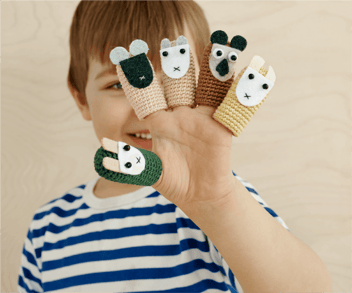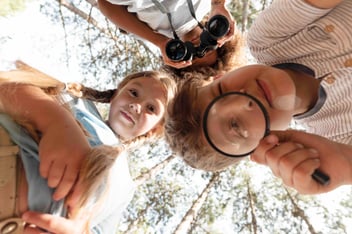Curiosity & Creativity as crucial as intelligence for academic success

Curiosity and creativity are not just buzzwords; they are fundamental components that encourage children to explore, question, and innovate. Curiosity and creativity go hand-in-hand in the Early Childhood Education (ECE) setting as they both foster an environment where exploration and imagination thrive. When children are curious, they are driven to ask questions and seek answers, which naturally leads them to engage in creative thinking as they explore different possibilities. This dynamic interplay encourages children to consider new ideas, solve problems, and approach tasks with an innovative mindset.
In this blog post, we'll explore
- the academic success and holistic development that curiosity and creativity bring by research
- the practice of curiosity and creativity in the HEI Schools Approach
- tips for you to start cultivating curiosity and creativity in your school
1. Academic Success Driven by Curiosity and Creativity

The Academic Rewards of Nurturing Curiosity
Curiosity is often described as the thirst for knowledge, a natural trait that propels children to explore and learn. Research has consistently shown that curious students perform better academically. A study conducted in 2018 by the University of Michigan found that curiosity is as important as intelligence in determining a child's academic success. The study revealed that curious students tend to engage more deeply with their educational material, leading to higher achievement levels.
Curiosity encourages active learning, where students seek answers to questions they pose, transforming the learning process into an exciting adventure. This exploratory approach fosters a deeper understanding of subjects, resulting in improved retention and critical thinking skills. When educators cultivate curiosity, they empower students to become lifelong learners, eager to expand their horizons.
Creativity as a Catalyst for Academic Excellence
Creativity, often associated with artistic expression, extends far beyond the realm of art. It plays a significant role in academic success by encouraging innovative thinking and problem-solving. Research conducted by the Torrance Center for Creativity and Talent Development highlights that creativity is a strong predictor of academic achievement across various subjects, including math and science.
Creative students possess the ability to think outside the box, approach problems from multiple angles, and devise novel solutions. This flexibility in thinking enhances their capacity to tackle complex academic challenges. By fostering creativity, educators equip students with the tools to thrive in diverse academic environments, paving the way for future success.
2. The Holistic Benefits of Curiosity and Creativity Beyond Academia

Curiosity as a Driver of Personal Growth
Curiosity extends beyond the classroom, playing a pivotal role in a child's overall development. It fuels a sense of wonder and exploration, encouraging children to venture into new experiences and environments. The renowned psychologist Dr. Laura Schulz emphasizes that curiosity is a fundamental aspect of human cognition, driving us to make sense of the world around us.
Curiosity nurtures a spirit of inquiry, fostering the development of essential life skills such as resilience and adaptability. Curious children are more likely to embrace challenges, view failures as opportunities for growth, and persevere in the face of adversity. These qualities contribute to their personal development, helping them become well-rounded individuals capable of navigating the complexities of life.
Cultivating Creativity for Social and Emotional Well-being
Creativity not only enhances cognitive abilities but also nurtures social and emotional well-being. Engaging in creative activities allows children to express themselves, develop their unique identities, and build self-confidence. The American Psychological Association highlights that creative expression promotes emotional regulation and stress relief, providing children with a healthy outlet for their emotions.
Creative endeavors encourage collaboration and communication, as children often work together on projects, sharing ideas and perspectives. This collaborative experience fosters social skills, empathy, and an appreciation for diversity. By prioritizing creativity, educators help children build meaningful relationships and develop a sense of belonging within their communities.
3. The Practice of Curiosity and Creativity in the HEI Schools Approach

Curiosity and Creativity as Guiding Principles
At HEI Schools, we prioritize curiosity and creativity as essential components of a quality education. These elements form the core of the HEI Way, which is a set of principles that build our Curriculum and guide our Pedagogy. Alongside Curiosity and Creativity, the HEI Way also includes four additional guiding principles: Active Participation, Culture of Trust, Sustainable Living, and Learning Anywhere, Anytime.
In HEI Schools' Holistic Curriculum, we nurture curiosity and creativity everywhere possible, not just in classroom. Our approach, inspired by Finland's educational philosophy, emphasizes hands-on activities, open-ended projects, and interactive learning experiences across all aspects of education. We prioritize a child-centered methodology, empowering students to explore their interests with the support of our dedicated educators. We aim to cultivate a lifelong love of learning in every child by fostering an environment of exploration and innovation throughout our curriculum.
Create an Environment of Curiosity & Creativity
Teachers play a vital role in nurturing curiosity and creativity in the classroom. At HEI Schools, we provide our teachers with professional development opportunities and resources to enhance their teaching practices. We encourage them to adopt innovative teaching methods, incorporate creative activities, and facilitate meaningful discussions that spark curiosity. Through ongoing training and collaboration, our teachers are equipped to create engaging and inclusive learning environments that cater to the diverse needs of each child.
4. How to Begin Cultivating a Culture of Curiosity and Creativity in Your School
.jpg?width=800&height=300&name=How%20to%20Begin%20Cultivating%20a%20Culture%20of%20Curiosity%20and%20Creativity%20in%20Your%20School%20(1).jpg)
Curiosity and creativity are vital components for fostering an engaging learning environment. They act as the catalyst that fuels students' imaginations and ignites their passion for learning. Just as gardens flourish with the right care and resources, schools thrive when they encourage exploration and innovative thinking.
So, how can educational leaders and school owners nurture this culture?
- Promote Inquiry-Based Learning: Encourage educators to embrace students' natural curiosity by fostering an environment where questions are welcomed. Facilitate discussions that allow students to delve deeper into topics and explore answers collaboratively, strengthening their critical thinking skills.
- Provide Diverse Learning Opportunities: Create programs that encourage discovery through hands-on experiences like art, science projects, and creative writing. By offering a variety of avenues for expression, you allow students to explore their interests and develop their unique voices.
- Establish a Supportive Environment for Experimentation: Cultivate a school culture where mistakes are viewed as opportunities for growth. Encourage teachers and students to take risks in their learning processes, fostering a mindset that values innovation over perfection. This will inspire creativity and resilience among both students and staff.
Conclusion
Curiosity and creativity are not mere add-ons to education; they are essential ingredients that unlock a child's full potential. Research unequivocally demonstrates their impact on academic success, personal growth, and social and emotional well-being. By nurturing these qualities in young learners, educators and child development experts can pave the way for future leaders, innovators, and critical thinkers.
![]() The HEI Schools Approach embodies these principles, placing curiosity and creativity at the heart of our educational philosophy. Explore the possibilities of nurturing curiosity and creativity in your educational setting by partnering with HEI Schools. Contact us today to learn how HEI Curriculum can help your school provide the quality education that all children deserve.
The HEI Schools Approach embodies these principles, placing curiosity and creativity at the heart of our educational philosophy. Explore the possibilities of nurturing curiosity and creativity in your educational setting by partnering with HEI Schools. Contact us today to learn how HEI Curriculum can help your school provide the quality education that all children deserve.
References
- Torrance, E. P. (2008). The Torrance Tests of Creative Thinking. Scholastic Testing Services.
- Schulz, L. (2011). Explaining the Development of Curiosity: A Human-Cognitive Perspective. Developmental Psychology.
- American Psychological Association. (2013). The Role of Creative Expression in the Development of Emotional Regulation in Children. Psychology of Aesthetics, Creativity, and the Arts
- Shah PE, Weeks HM, Richards B, Kaciroti N. (2018). Early childhood curiosity and kindergarten reading and math academic achievement. University of Michigan.




